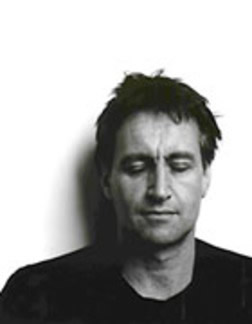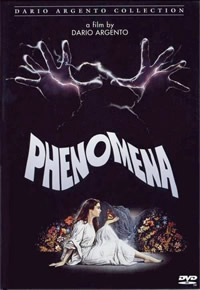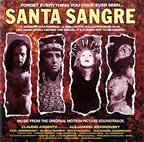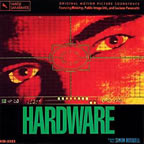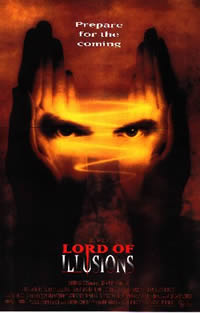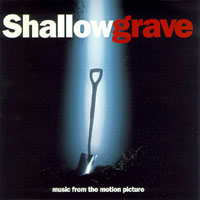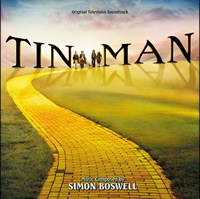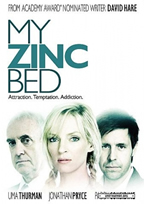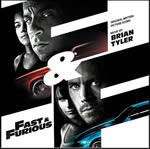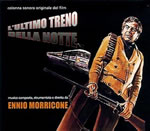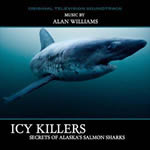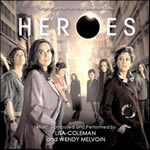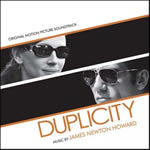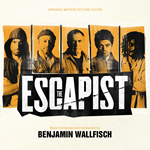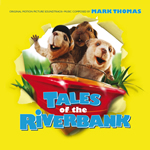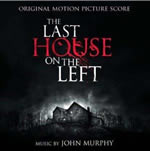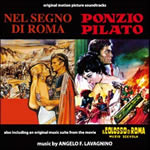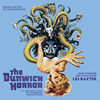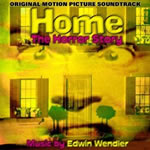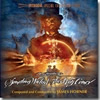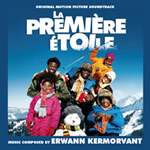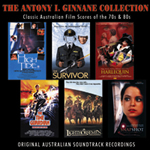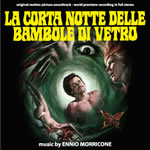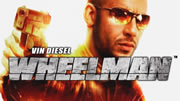 |
Soundtrax: Episode 2009-6
May 5th, 2009By Randall D. Larson
Simon Boswell Lord of Musical Illusions:
A Conversation with Simon BoswellSimon Boswell is a British film composer whose work has spanned a myriad of genres and musical styles, from the giallo films of Dario Argento and Clive Barker’s masterful Lord of Illusions, Alejandro Jodorowski’s Santa Sangre, Danny Boyle’s Shallow Grave, to the recent two-part TV miniseries, Tin Man. I took a walk recently with Simon down his career path recently and gleaned some intriguing perspectives on his work and experiences in film music.
Q: What was it that led you into film music, and how did you manage the move from pop star and producer into film composer? How did you learn the intricate craft of composing music for the silver screen?
Simon Boswell: I had no plan to be a film composer. In fact I was completely ignorant about it. As a child, I was fascinated by the music to a film called Exodus and persuaded my parents to buy me the sheet music. I also saw Lawrence of Arabia quite young and was struck by that score. That was it, really, until I was actually asked to compose for a film. I was, however, a precocious pianist and, at age 8, inspired by a BBC Radio program about Mozart, wrote a theme and variations to it in the styles of Chopin, Bach, Mozart, and Rachmaninov. I studiously wrote these out on manuscript. I studied the piano from age 5 till about 15. When I was 12, I saw Jimi Hendrix on TV and was mesmerized. With my brother, Chris’ help, I learnt the guitar. Around about that time, I also decided that a low slung electric guitar was a sexier proposition than a formal looking piano stool for impressing girls. From that moment on, classical piano and rock guitar lived side by side in my head. I actually became a very accomplished finger picking acoustic guitarist and recorded some fiendishly fast guitar instrumentals for Transatlantic Records when I was 18 (whilst still at Cambridge studying English Literature). I then recorded a solo album, The Mind Parasites, for the same label. After a few years in bands with deals at EMI and A&M Records, I became a record producer. This led me to Italy during the early 1980’s, where I had much success, and was introduced to Italian horror director Dario Argento.
Q: Your first effort in film music was working on Dario Argento’s Phenomena, which also included music by the band Goblin. How did you first become involved in this film, and the succeeding “giallo” scores you did in Italy?
Simon Boswell: Dario had seen me play in a club in Rome whilst I was touring with my band Live Wire and he asked me if I would contribute to his film Phenomena. He suggested that I work with two of the musicians from Goblin on this film. I think he was trying to branch out a bit musically at this point in time. He also got Rolling Stones’ Bill Wyman to contribute some cues, and we had tracks from Iron Maiden, Motorhead and others.
Q: What music did you write for Phenomenon, and how did you work with Dario Argento to musically enhance his vision for this film?
Simon Boswell: I worked with Claudio Simonetti and Fabio Pignatelli for a few days but things did not go smoothly. How could they? They had scored all Dario’s previous movies on their own. We decided to split into separate studios to accomplish the score. I contributed about three themes plus two really rocking songs that I wrote and performed with one of the singers I had produced in London: Andi Sex Gang (check out ‘The Naked And The Dead’ on YouTube! All the instruments are me; the voices, Andi).
With this, my first attempt at film music, I essentially created a collage of unlistenable sounds – feedback guitar, violin harmonics, the scrape of a plectrum down the strings of my Strat and the wailing and moaning of green-haired Andi Sex Gang. When Dario first sat down and listened to it, the aural equivalent of running your fingernails down a blackboard (remember those?), he pronounced it: ‘Beautiful!’ I can’t tell you how many avenues opened up in my head at that point in time. I was walking on air!I had no idea how to actually write a film score. I think this has helped me hugely in my career. To be honest, I think you can only be taught how to write a score that someone else has already written. What’s the point in that? I loathe, for example, all generic music, whether pop or classical, but especially the kind of wallpaper that you hear on so many movies. When studying English Literature, I learnt that really bad Elizabethan poetry used what is called the ‘stock response’ in place of real feeling, to appeal to the reader – we would call it cliché. In fact, that’s exactly how I view 90% of film music. And when I feel I’m being manipulated, brazenly, by something really obvious, I cringe. Being moved by something powerful, emotional, and original is something else. Sadly, this has excluded me from working very much in Hollywood! But sometimes, through sheer ignorance, asking the impossible of an orchestra can give great results. After the moaning and giggling you find most musicians are really up for a bit of experimentation. If you’re honest and admit to not knowing it all, they will help you come up with something unique. Show them the parameters of what you need and they’re more helpful and less intimidating than you would think. I was always inspired by the ending of ‘A Day in the Life,’ by The Beatles and have made it my business to orchestrate some of that kind of chaos into my scores.
Q: Your first score for Lamberto Bava, another legend of Italian horror cinema, was Demoni 2. How did you work with him to determine the kind of music you and he felt was appropriate for the film, and how did it develop throughout the project?
Simon Boswell: Lamberto gave me complete freedom to write whatever I liked for his films. I would go to Rome for a couple of days and sit in the editing suite and go through the film, then take a VHS back to UK where I would compose and perform the whole thing on my own in a bedroom in Clapham, London. Sometimes I would take the music back to Rome and supervise synchronizing it on the movieola. There was very little communication.
Q: How did you extend or revisit this score when you composed the sequels, Demoni 3 and Demons 5 (La Maschera Del Demonio)?
Simon Boswell: The Italians often made sequels and reused my scores without telling me! Demoni 3 may be a case in point. Or it may have been called something else at the time. I can’t remember.
Q: Do you have any particular recollections of scoring subsequent films for Bava, such as Graveyard Disturbance (Una Notte Al Cimitero), Fino Alla Morte (Until Death), Delirium, Dinner With A Vampire Maestro Del Terrore, etc? What did you find to be most challenging about scoring these pictures?
Simon Boswell: My main recollection is that Lamberto made four films in one summer using the same set - so I can be forgiven for confusing some of them! There’s a rock song on the opening titles of Graveyard Disturbance which I wrote called ‘Imagination.’ This song has never been released but has been used in at least 8 movies – you know, on the radio, in the background in a café, etc. I’m still fond of that track.
Q: Italian horror/giallo films have had maintained a fairly unique musical style throughout the 70s and 80s, noted for a strong mixture of rock/jazz/pop styles along with very lush orchestral and/or vocal melodies. With that in mind, what do you feel has been unique about your own efforts in Italian horror film music and how have you tried to invest your own voice into this musical genre?
Simon Boswell: My coming of age as a film composer coincided with the development of early synthesizers, samplers and sequencers. So these were the basis of those early scores. I pretty much lived in a musical vacuum, but I became interested in producing slowly changing ambient sounds – and also what is, to modern ears, very mechanical, sequenced music. I’ve been told over the years that my style was similar to Tangerine Dream, but I wouldn’t know!
Q: What was the post-production environment when you were scoring these pictures – how much time did you generally have and what type of ensembles would budgets allow?
Simon Boswell: After the first five or six Italian films, I would get phone calls from filmmakers I had never met saying: “We’re making a film. Can you write a tension theme? Make it five minutes long. And an action theme – make it five minutes long. And a love theme - ditto.”
I would send this music to people I have never met for movies I have never seen! One month a horror film, the next a Rambo rip-off. Then a romantic comedy followed by a Kung Fu movie. Amazing training for a composer. On average, about four weeks to deliver the finished score. On one occasion I was asked to do a whole film in three days! Sometimes I would take the music out to Rome and I have watched editors put it against picture and when it stopped working for them, they would cut to another piece! It had the effect of propelling the viewer through the movie with very broad strokes, like a Picasso painting. This gave a unique style to many Italian films of that period – it’s the same in a lot of their spaghetti westerns, where the bad dubbing also contributes to the dislocated reality of the genre.Q: What kind of score did you write for Michele Soavre’s Acquarius (aka Deliria, or Stage Fright in the UK)?
Simon Boswell: Shortly after Phenomena, I did this movie with Dario’s Assistant Director, Michele Soave. Great film. Like most of those scores it was all electronic. I may have been one of the first to use drum loops under strings – I remember sampling the ‘funky drummer’ back in 1986 in my prototype sampler that would hold a maximum of 3 seconds in its memory!
Q: You scored Alejandro Jodorowski’s Santa Sangre. How did you find working with this director (who previously composed his own scores for films like El Topo)?
Simon Boswell: I consider Santa Sangre to be the greatest film I’ve been involved with. Dario’s brother, Claudio Argento, produced it. Alejandro was a great inspiration. There is a scene in Santa Sangre where one of the characters has her arms cut off. I asked Alejandro if he would like this to be a violent piece of music. He said: “No! It must be wonderful! Heavenly!” It was Alejandro who taught me that you can write beautiful music for violent images and, in so doing, establish a resonance between what you see and what you hear. This can give great depth. Much of film scoring that I hear is saying the same thing twice. I mean, we can see the hero is in a violent struggle with his nemesis - why underline it with a thick black pencil? I think many filmmakers assume that the audience is stupid.
Q: How would you describe your score to the science fiction thriller, Hardware? What kind of music did this Terminator-styled film evoke from you, and how did you enhance its sci-fi elements musically?
Simon Boswell: Ah, Richard Stanley. Richard is such an undiscovered genius. But we’re hoping to change that shortly with a new movie after far too long! I’ve written music for everything Richard has done. In Hardware we wanted to create an atmosphere for a post-apocalyptic world that was hi-tech but infused with the dirty reality of life stripped of its comforts. I came up with the idea of combining Paris Texas-esque slide guitar with electronic ambience and Stravinsky-ish orchestral madness.
Q: Clive Barker’s Lord Of Illusions was a somewhat differently toned horror film. How was the score developed and how would you describe your musical approach to this particular film?
Simon Boswell: Clive wanted to make the hero a Philip Marlowe type cop immersed in a world of bizarre horror. So the score is a mixture of cool sax and atonal nastiness. There were so many blue screen effects when I wrote and recorded this score that about 90% of the movie was unlocked! We recorded the orchestra in the famous grunge studio Bad Animals in Seattle (Nirvana and Pearl Jam recorded there). There was a lot of editing after the event!
Q: Lord Of Illusions is a particularly engaging score, with a striking noir-ish saxophone melody for the Marlowesque detective and all manner of intriguing sound textures, furiously surging orchestral measures, and frightening strange sounds. How did you come to integrate its diverse parts?
Simon Boswell: After Clive hired me, he was impatient to hear the noir theme for his lead character, so I worked first on this in London. Clive loved the rough version, for which I used a sampled sax, so I headed for LA for a two month stay. Much of the rest of the score consisted of atonal clusters and disturbing textures. Orchestrator William Kidd and I worked up some deliberately unplayable sketches for the orchestra in Seattle. We wanted to record the chaos of musicians slowly realizing that their parts were technically impossible. Much amusement was had by all. There were real themes as well and I took everything back to LA to put together with the ever-changing picture. Clive had also asked Diamanda Galas to provide a song for the soundtrack and I asked her for some additional vocal weirdness which she duly provided. This is woven into the orchestral score. I had rented a house from Dave Stewart of the Eurhythmics, just before he sold it to the late Michael Kamen. My family joined me there, but, after they later left for the UK, leaving me alone in this huge place, I remember getting completely freaked out late at night with only the images from Lord of Illusions and the madness of my score for company!
Q: By the mid 1990s you seem to have changed direction, with opportunities to compose dramas and comedies, notably scores like The War Zone, Cousin Bette, The River King, And The Secret Glory. How did you find scoring films of a less violence nature, and what musical new opportunities did these films offer you?
Simon Boswell: To be honest, it was an accident that I became a film composer, and equally so that I made so many dark scores for so many violent films. It was a great relief to be allowed to express other sides of my personality. War Zone, River King and Cousin Bette are all favorites of mine. River King, especially. Large parts of that score are written and performed by two harps, two guitars, mandolin, banjo and strings. That was very refreshing for me. I’m not going to pretend that I don’t have a very dark heart, but I can also write a love theme with the best of them!
Q: A Midsummer Night’s Dream seemed to afford an especially rich musical canvas. How would you describe your musical approach to its fantasy world?
Simon Boswell: After Zbigniew Preisner was fired from this movie I got a call at midnight asking me to be on a plane at 10am the next day to fly to George Lucas’ Skywalker Ranch in California. The movie is a real treat with exceptional performances by Kevin Kline, Michelle Pfeiffer, Rupert Everett, and many others. Having studied English Literature I was very familiar with the Shakespeare play. Michael Hoffman had set it in Tuscany, Italy around the 1900’s and wanted to use a lot of bel canto Italian Opera – Puccini, Bellini, Mascagni. Part of my job was to compose pieces that linked to and developed from those famous tunes. So a lot of the time you think you’re hearing Mascagni, for example, but that was a minute ago! Now it’s me. I don’t think many people gave me credit for that! But the most interesting part of the score was undoubtedly the music in the fairy world. In discussion with Michael, we decided to make the fairy sound an exotic mixture of Indian, Middle Eastern and Medieval instruments, mixed with Western orchestra. It was great fun. I mixed Shawms, a Qanun – a kind of Arabic Dulcimer – a host of wooden whistles and African flutes, Dumbeks, Tablas – you name it. I’m particularly proud of this score.
Q: You scored Shallow Grave for Danny Boyle. How was this experience for you and how did you develop the score for this film?
Simon Boswell: Danny Boyle was one of the many Dario Argento fans who hired me over the years. Shallow Grave went on to be a huge success, but at the time we worked on it, it was, of course, an unknown commodity. My budget was small, and everything was, as with my Italian movies, all accomplished in the tiny spare bedroom in Clapham. The film occupies that strange territory between horror and comedy. One should very rarely make the music comic in itself, so I decided that there was a lot of humor to be had simply by repeating what is basically quite a serious theme in a kind of oh-no-here-we-go-again kind of way! I spent some time editing the techno track by Leftfield to get it to fit the opening titles.
Q: You also scored Boyle’s 2002 short Alien Love Triangle – what kind of music did this picture require of you; and was challenges did composing for a short rather than a fully developed feature film pose for you?
Simon Boswell: This was supposed to be one third of a trilogy to make one movie. The other two never got made. Quite simply, Danny and I decided to try and make the most unlikely and ridiculous score ever made: we chose to do it all with steel drums! I can only think of one worse option and that would have been bagpipes! But I could not inflict that on either myself or the public.
Q: You won a best score award in Norway for your music for the animated feature Free Jimmy. How did you approach scoring this film?
Simon Boswell: There were so many different styles required for this that I enjoyed it more than any other film I’ve worked on. The opening titles were pure Hitchcock. The next cue was a piss-take of a 70’s cop show theme. Then came jazz vibes, a lot of Big Top circus music, and finally a 20-minute sequence with no dialogue in which I had to tell the story, in music, of a moose befriending an elephant and helping him to come off heroin! The Rite of Spring was an inspiration. The end title was a cover version of the Velvet Underground song ‘I’m Set Free’ that Lou Reed very kindly allowed us to make. I did this with the band The Kills.
Q: Your score to 2006’s Incubus provided a very interesting and spooky assemblage of windy synth tonalities, atonal shuffling, and eerie voicings, which gives Tara Reid’s interminable flashlight-lit wanderings through the dark cavernous hallways a very frightening ambience. When you are trying to enhance the scariness of a picture like this, what techniques do you find most effective in using “sound mass” kind of material and yet keeping it musical, coherent, and interesting?
Simon Boswell: I like what you call ‘sound mass’ because it’s very vagueness allows the audience their own interpretation and it gives the impression of hanging in space, being cut adrift from regular time signatures or pitch. So there’s no comfort in it. Ambient sounds fascinate me but I always make sure that there’s some musical element or repetition in there that distinguishes it from pure sound design and in which the listener can take some refuge – or be manipulated by the expectation of something which doesn’t always happen when they think it will. To make the score to Incubus, I just experimented with some of the weirder sounds I had collected over the years.
Q: Your recent score for the miniseries Tin Man also provided a rich tapestry for music. Would you describe how you constructed your score (thematically and instrumentally) to embellish the film’s story, characters, and environment?
Simon Boswell: The story takes the characters from The Wizard of Oz and creates a new world for them. I was instructed, however, that I could not go within a million miles of any of the music from the original film. The music ranges from epic sci-fi to grand, sweeping romantic themes, with a lot of fantasy and tension in between. When they mixed the movie, my own slight irritation is that they took one particular piece of the main theme and stuck it everywhere! This is the fate for many composers. We are not in control of the final outcome and pieces written for different scenes are often transposed to other places. In this instance it made it appear that I had run out of ideas. But it’s a minor quibble and I’m generally very pleased with the thing. Rich Walters, the music editor did a phenomenal job!
Q: You’ve also recent scored films on Norway (Rovdyr, Naboer). How did these assignments come about and what musical opportunities did they offer you?
Simon Boswell: The Norwegian makers of Naboer were big fans of Shallow Grave. We decided to do a very Bernard Hermannesque score – more thriller than horror, though the film has its moments! It was brilliantly executed movie – claustrophobic and scary – much like a Polanski film.
Patrik Syversen, the director of Rovdyr, tracked me down at the awards ceremony in Norway where I had won the best score for Free Jimmy. He had a tiny budget for the whole project, but really made it count and created a fine film. The score is all electronic except for the addition of solo cello which at times lifts it into a strangely sympathetic area.
Q: Your most recent score was My Zinc Bed for Anthony Page, an unusual domestic drama – and a far cry from Demons 2 or Incubus. What can you tell us about this new score – and what’s up for you next?
Simon Boswell: This film is superbly written (David Hare), directed (Anthony Page), and acted (Uma Thurman and Jonathan Pryce). It’s about addiction. The tough part was to compose music that did not intrude too much into such a delicate drama or lead the audience in obvious ways. It’s very organic – all orchestral. I’m firmly of the view that when you have such an amazing cast performing at the top of their game, you only need music if it’s going to tell you something you haven’t already been told!
I am currently working on my own art project called Blink. These are video portraits of World Leaders and celebrities derived from famous news events that hover in front of you and blink! The movements of their facial gestures are scored with music.
Q: Although, you’ve scored many different types of films over the last 24 years, you have demonstrated an affinity for fantasy-horror films, which keep showing up on your filmography! What do you think it is about your music that has led to your recurring efforts in these genres? Are they any musical opportunities that you have found unique to this genre? Are there other types of films you would enjoy scoring that you may not have had the opportunity to compose yet?
Simon Boswell: Clearly I have a dark side and find it easy to express this in ever changing ways, so perhaps my excursions into horror were not pure coincidence. Fantasy films allow you to be more experimental. I get bored doing the same thing over and over and relish new territory. But being versatile is clearly a disadvantage in the film world. People want to hire ‘that horror guy’ or ‘that action guy.’ Fortunately I’ve done enough in many different genres to have many different nests of fans!
Thanks to Simon Boswell for taking the time to share his perspectives with BUYSOUNDTRAX. Photos of Simon Boswell by Bryan Adams (yes, he is a terrific photographer also!). For more information on Simon Boswell, see his web site at www.simonboswell.com
New Soundtrax in Review
Brian Tyler’s latest foray into high-octane film scoring is Fast and Furious, the fourth propulsive start in the film franchise that began with The Fast and The Furious in 2001. That film was scored by electronica wizard BT, while the second, 2 Fast 2 Furious, was composed by David Arnold. Tyler entered the franchise race in 2006 with Tokyo Drift, a winning score in all respects; and he deserves another checkered flag for his latest effort, released on CD by Varese Sarabande. The score is built around a percussive, synthetic rhythmic riff that takes off in “Landtrain” and gives the score its aggressive drive and thrust. The motif recurs frequently throughout the score; listening to it at home you’ll swear your room is moving at 200 MPH. But the score is about much more than velocity; as Tyler typically humanizes the action film with a quantity of very eloquent cues. While the main theme is all about propulsion and momentum, tracks like “Letty” and “Amends” and “Suite” and “Brian and Mia” are gracefully reflective and poignant moments that really become the high points of the score with their expressivity. The mixture of high speed riffing and reflective sensitivity makes for a multifaceted score that, while much of it was buried beneath revving engines and screeching tires on the theater, makes for a compelling listen on cd.
Ennio Morricone’s score for the 1975 Aldo Lado giallo thriller, L'ultimo treno della note (aka Last Stop on the Night Train; aka The Night Train Murders) was previously only released as a two-track 45-rpm single by Cinevox concurrently with the film. Cinevox has now released the entire score, in full stereo, in a handsome package which really shows what a richly detailed and persuasive score this is. The score develops a pair of themes, the first of which, associated with the night-time train ride on which the events take place, adopts the literal sound of the clacking train wheels and onrushing passenger consist for its musical base, over which a plaintive harmonica melody drifts like a steam train’s hefty smoke trail. The mixture of the real sounds of the onrushing train balanced with the furtive tones of the multi-tracked harmonica as it plays off of itself make for a fascinating sound texture. The second theme is called “Coincidenza,” initially introduced in the middle of the first theme, where it forms a bridge for somewhat warbled, growling woodwind melody over a severely pounded piano; in the track title of the same name it is developed with further variance into a nightmarish mélange of interlayered wailing harmonicas and pounding keyboards, savagely creating an oppressive atmosphere of claustrophobic entrapment. With this new edition expanding these themes by fifteen more tracks, each of which is a variation of the primary pair of motifs, this score really comes to life. Far from being and endless rehash of the same basic material, each variant captures a unique flavor, such as the drifting oboes paired with an especially clear-toned and reflective harmonica performance on “Version 2;” the strident harpsichord notes playing underneath strings and opening into a lovely lyrical melody in “Tema Solitudine” (the keyboard melody is very close to one from another Morricone score that I can’t quite place at the moment; it is reprised for solo piano in “Tema Solitudine No. 2” and for piano and harmonica in “Tema Solitudine No. 3”); the addition of a whistler to the front end of the main theme in “Version 3;” a compelling solo harmonica variant in Version 9. Having known only the two tracks from the original single release, hearing the complete score in all its many variations is a strikingly eye-opening (ear-opening?) experience, revealing what an exceptional score this is and how fascinating and inventive an accompaniment the composer provided for this otherwise fairly shallow thriller.
Alan Williams’ latest documentary score, for Icy Killers: Secrets of Alaska’s Salmon Sharks, broadcast recently on the National Geographic Channel, is available on the composer’s label, Silverscreen Music. The film tells of the confluence two massive migrations: the David & Goliath story of ravenous sharks (the only species known to thrive in Alaska’s icy waters) and spawning salmon in Prince William Sound. Williams’ melodic orchestral score lends an air of adventure to the film’s mesmerizing photography, from its majestic Arctic vistas to its intimate underwater dazzle. “Journey to Prince William Sound” takes us far north with graceful sonority before turning slightly savage, with angular shards of stroked violin over a running melody line as the hungry inhabitants of those northern waters are made known. “Spring,” as the season of reawakening suggests, blossoms with a glorious bouquet of strings punctuated by low, pounding piano before opening into a glistening froth of light strings and harp. Williams brings to life various species of sea life that pass in front of the lens, from the slow, stalking figures of strings and synths for “Orcas” and the eloquent and majestic undulations of winds and piano for “Humpbacks” to the more sprightly measures of piano for “Sea Otters and Harbor Seals” and the wispy, string-drawn trails of the luminescent “Jellyfish.” But the heart of the story, and score, is the tale of survival and sustenance that plays out between the salmon and their namesake sharks. Williams draws this with icy tones and slow-moving, weighty orchestration, somber and serious sonorities; his Main Title, “Icy Killers,” is driven with strong percussion, a slow-moving synth-wind melody drifting between the icy shards of violins like a shark’s purposeful, submerged approach; it becomes a piercing action theme, driven by drums that reflect both the animal’s primitive design and the ferocity of its attack. “On The Prowl” and “Group Hunting” both reprise this motif with advancing progression, the latter reprising the synth-wind melody that becomes the cold, hungry voice of the prowling shark – or the driven cry of the spawning salmon. “Winter Hunt” is somber and menacing, the light cavorting of the seals and drifting ballet of jellyfish having given way to the sobering duty of feeding and the clear attention of the sharks. The score is attractive and poetic on CD, painting an intriguing portrait of both hunter and prey, and the environment in which their ongoing dance is carried out.
www.alanwilliams.com
La-La Land Records has released the original score to the hit NBC series Heroes, scored by the composing team and recording artists Lisa Coleman & Wendy Melvoin (aka Wendy & Lisa) (Dangerous Minds, Soul Food, TV’s Crossing Jordan, TV’s Bionic Woman). A songtrack album was released a year ago, but now we have the show’s vital underscore. With a title theme that lasts a mere 14 seconds (a whistling rush of wind and swirling strings), the heart of the score is in the seven character-driven themes that follow, each one representing a different character in the Heroes universe. (“Every character on Heroes has their own musical profile which is a unique combination of sounds, instruments, and musical themes,” writes producer Allan Arkush in the album notes. “These musical profiles are shaped to follow the arc of a scene, build tension, provide humor, give a story a sense of closure or an action scene a climax.”) Rather than organizing the album around specific episode scores, the album, like the show, is character driven, with the eight tracks after the brief title moment taking characters’ motifs and developing them progressively, in the manner of ambient or atmospheric music, throughout a five to eight minute segment. They are tone and rhythm based, with minimal melodies and occasional dissonances, creating underlying atmospheres and progressive musical reflections – Heroes is not about rousing super-hero music but rather sensitive and almost spiritual music that is reflective of the inner core of the characters as they deal with their powers and what it means to them. The music, therefore, is quiet, understated, somewhat oblique as it reflects subtexts and inner thoughts and feelings. Track 9, “Kirby Plaza,” is a situation-based cue, from the final episode of Season 1, which gathers all the characters together in one place. The cue ranges from nightmarish discord through a brief action riff, into a splendid neo-spiritual atmosphere of regeneration and renewal the concluded the season. The album ends with the fan favorite “Fire and Regeneration,” which the composers propose embodies the “sound of Heroes.” It had previously appeared on the songtrack album, and is one of several cues on this album to feature vocalist/musician Shenkar (Passion Of The Christ, Jacob's Ladder), who’s wordless singing embodies the soul of the characters, united, and of their shared experience. Its eloquent phrasing is about as heroic as the composers allow themselves to get.
The crime thriller Duplicity, soundtrack released on CD by Varese Sarabande, affords James Newton Howard the opportunity to branch out into wholly new territory with a marvelously catchy, contemporary, and stylishly jazzy assortment of instrumental riffs than enliven this entertaining film. The score is a departure for Howard, who is perhaps best known for heavily orchestral work such as his recent scores for I Am Legend, The Happening, and The Dark Knight. While Howard has scored lighter fare (he completed Confessions of a Shopaholic prior to Duplicity, and comedy scores like Mad Money and RV appear on his recent roster), but the style of Duplicity is a fresh approach for JNH. Rather than developing theme-and-variation, Duplicity’s score consists of extended riffing on percussive jazzy patterns, guitar-laden acoustics, strident and straight-ahead violin measures, all of which congeals into a very likable mix of zesty rhythms and lightly dusted textures. The mostly orchestral performance gives this gentle humorous caper movie the perfect sense of arrogant self-confidence if needs to reflect the operations of corporate spies Clive Owen and Julia Roberts as they pull off a con on their big business bosses and perhaps betray each other in the process. The style also provides a light touch to the proceedings and invigorates the action without trivializing it; a percussive cadence keeps the adventure moving forward, but the breezy texture gives the score a thoroughly agreeable flavoring. “The Frame Up” is ideal caper music, filled with tension, confidence, purpose, timing, excitement, and vitality; use of Latin-flavored acoustic guitar ties in with the Miami locale in which a portion of the adventures occur, although excursions to London, Rome, and Cleveland do not weigh in heavily on the musical form. A pretty acoustic guitar romantic melody serves as a soft love theme in “Airport Love,” and the score concludes nicely with a friendly flamenco-styled guitar resolution in “Duplicitá a Due.” A concluding song called “Being Bad” by trip-hop duo Bitter-Sweet closes the album (an instrumental version of one of their earlier songs had been used in the film’s trailer).
MovieScoreMedia has released the soundtrack to Rupert Wyatt's acclaimed thrillerThe Escapist, which is the label’s second collaboration with composer Benjamin Wallfisch (the first one was Dear Wendy). The score received a nomination for the prestigious Ivor Novello Award for Best Original Film Score from the British Academy of Songwriters, Composers and Authors (BASCA). The soundtrack is now available online and will be released on CD on May 5. Wallfisch’s score is built around an aggressive main theme that captures a percussive propulsion and really drives the action. It’s a gripping theme – strident violin strokes punctuated by percussion, over which an angular piano melody flies, enhanced by higher strings and winds – that works very well in a number of permutations. Cimbalom also provides an earthy texture for later renditions of the theme, as in “Diamond.” Set against this is a moody vocal motif with cello introduced in “The Confessional,” working into a paean of heartbreaking beauty (reprised in “Frank’s Vision”). The primary motif dominated the score in various interpretations, from the panicky, “scattered” light percussive flavorings of “Viv’s Lab” and “Into The Dryer” to synth keyboard variant in “Sump Chase,” the somber pensive tonalities – brooding rhythmic keyboards, rustling metal drums, impatient string bowings – of “The Trade,” or the eerie, dissonant synth patterns that back it in the suspenseful “Lacey Hunted.” “Elegy for Brodie” is a brief but poignant moment of passionate melody; although the succeeding “Tony Killed” brings us quickly out of it with repeated glissandi of nightmarishly ascending and descending synth scrapes and patterns. Wallfisch’s two themes merge very nicely in “Lacey Is Free,” the soothing sonority of the poignant vocalism subjugating the harsh panic of the percussive theme, although the latter remains in nuances, as the memory of Lacey’s experience endured but not exorcised.
The score retains a compelling breadth of sound throughout, with piano and cimbalom radiant over their rhythmic bed of strings and percussion, the voicings of the “Confessional” airy and human in contrast to the relentless rapidity of the villain’s motif. A very nice score in all respects.
British composer Mark Thomas (Dog Soldiers, Merlin: The Return) has composed a delightfully melodic orchestral score for Tales of the Riverbank, an animated film version of the well-known British children's story that tells of three friends – Hammy Hamster, Roderick Rat, and GP the Guinea Pig – who, having swept down the river in a violent storm, embark on an epic journey in search of their lost homes. This new film version features the voices of Stephen Fry, Ardal O'Hanlan, Jim Broadbent, and Steve Coogan. The score, released last month by MovieScore Media, is a lyrically pleasing journey rich is melodic effervescence, with the storyline providing all sorts of opportunities for marvelously exaggerated and heartfelt musical accompaniment. The score is a pleasantly varied one, almost cartoonlike in some of its manic flavorings – “In Search of a Boat” adopts a jaunty, antic-driven tune embellished with whistling; “One of Those Etceteras” opens into a cool and a compelling rhythmic jazz piece, reprised later in “Lost and Found;” “Can You Swim” assumes a momentary JAWS parody; “Up Up And Away” jockeys from slack-guitar to a bouncy woodwind riff, all very cute and fluffy – but it’s Thomas’ main theme that gives the episodic story its overarching sense of honor and dignity, and exaggerates these characteristics within the fluffy animals who populate the storyline (“Main Title,” “Flying Theme,” “Sonya’s Balloon,” and, of course, “Happy Ever After” replicate this most pleasingly). There are also moments of splendid drama, such as the climactic action cue, “Escape,” as pulse pounding as any big budget action fest score. Mark Thomas has composed a very expressive score which is thoroughly engaging and agreeable.
British film composer John Murphy has maneuvered through ongoing associations with Guy Ritchie (Lock Stock and Two Smoking Barrels, Snatch), Danny Boyle (28 Days Later, Sunshine), and others, has concocted a brutally spooky score for Dennis Iliads’ remake of the 1972 Wes Craven/Sean Cunningham low-budg classic horror film, The Last House on the Left, which in many ways defined the slasher movie as it came to be known in the later 1970s. The new film is co-produced in part by Craven and Cunningham and seems to be a potent, hi-budg rendition of their seminal horrorshow. The soundtrack album, released by La-La Land, is a cool mix of vibe riffing, atonal sound fusion, and disturbing atmospherics. It opens innocuously enough, with (after an eerie descending windy moan that anticipates later terrors; although an excellent alternate rendition, included on the CD, proffers a more evocatively spooky opening) a pleasant rhythm from strings, harp, and acoustic guitar; but soon enters dark territory. Murphy has describes, in a brief composer’s note in the album booklet, that he loved the film’s extremes of beauty and dread, and those two poles would form the crux of his approach to scoring the picture. The score takes us on a journey similar to that the characters take as they encounter the house, the villains, move to a place of apparent shelter only to discover greater terrors. So the score’s initial moments, as we are introduced to “The Pool” and “The House” and “The Boathouse,” consist of fairly pleasant melodies – “The House” contains a string motif that is almost cheerful – but then gradually grows darker, less agreeable, more disturbing – whooshing synth breaths and pensive string sonorities, low brass and synth moans, onrushing atonal stingers (such as the intense, prolonged drilling synth corkscrew midway through “In The Woods”). For the most part, though, Murphy keeps it pretty tonal, vague, fragmented melodies drifting amidst his layered string patterns with nuances of synth and samples providing intriguing sonic punctuation. As the journey reaches its conclusion, “The End” resolves the ambient miasma and segues into a quiet, reflective piano melody over strings, each of the keyboard’s twinkled notes echoing as if in an abandoned but very solid house, beauty once more emerging from hellish darkness. It’s a nicely progressive score, never falling into unlistenable chaotic dissonance, but whose tonal shadows drift purposefully toward a satisfying conclusion.
Digitmovies latest Italian Peplum restoration gathers three scores by Angelo Francesco Lavagnino into a splendid single-disc package. Two dozen cues from 1959’s Nel Segno De Roma (aka Sign of the Gladiator, starring Anita Ekberg and others in a sword-and-sandal story of ancient Rome), eight from 1962’s Ponzio Pilato (Pontius Pilate), a melodramatic post-Biblical story about a repentant Pilate in his later years, and a suite from 1964’s Il Colosso Di Roma (Hero of Rome) are gathered together to make a fine representation. In these mostly pre-Italian Western days, Lavagnino’s music is pretty straightforwardly orchestral, although he does make interesting use of an organ and choir in the scene introducing “Marco Valerius, Slave.” The music is mostly pretty bombastic, orchestra and choir representing the glory of ancient Rome (or, in Pilate’s case, the Holy Land) and the stalwart heroes that did battle therein (lots of exciting brass and percussion action music; “Bloody Fight in the Palace” is an especially fine cue), although it is not without its more sensitive and eloquent moments, as in Segno’s “The Fire and the Liberation of the Prisoners,” which marvelously moves from poignancy to high drama; the following “Assaulting the Oasis and Stirrings Of Love” accomplished a similar segue in reverse direction. Nel Segno includes a couple of notable love themes, “Julius and Bathsheba” and “Zenobia and Marcus Valerius” which recur in several cues (the latter cue is reprised very nicely with choir for the finale), and some source “court” music (The Market Of Palmyra,” “The Banquet and The Dance for the Court, etc.) and a few brassy military marches (“The Enemy Attack,” “Victory of the Roman Army,” “Triumphal Processional”) as well, which makes for a nicely varied and expressive score. Pilato is perhaps a more reverent score, as is befitting its topic, with a pompous martial motif for Pilate, a respectful tonality for “In His Name – Jesus of Nazareth” (strings and harp), “Pastoral Idyll” (flutes and harp), and “The Messiah” (strings, winds and harp), but it also has its rousing battle music (“After the Massacre”). A hymnlike choral motif serves a primary thematic element, although the score concludes with the lyrical soliloquy, “The Divine Justice.” The short (4:27) suite from Colosso Di Roma (which consists of the only original music written for the film; the balance of the score was recycled library music) is understated mysterioso, featuring eerie tonalities and suspenseful measures, interestingly textured for organ, harp, reverbed keyboards and percussion. As an original soundtrack from this era, the sound quality is thin but satisfying enough. Once again Digitmovies has done a great job rescuing these ancient scores from oblivion.
Film Scoring NewsGuy Ritchie's much anticipated Sherlock Holmes, starring Robert Downey Jr. as the title character and Jude Law as his sidekick Dr. Watson, will be scored by Hans Zimmer. Produced by Joel Silver and distributed by Warner Bros beginning on December 25, the film is of course based on the Arthur Conan Doyle characters but is said to re-introduce the world-famous sleuth as more of a martial arts wielding crime fighter than the somewhat laid-back Holmes we may be used to. – via upcomingfilmscores.com
Alan Williams just won his 8th Accolade Award for Best Original Score to the television documentary film Gettysburg: The Speech That Saved America. Entering its seventh year, The Accolade is an international, non-traditional, virtual venue. Awards go to those filmmakers who produce fresh, standout entertainment, animation and compelling documentaries. The Accolade is a showcase for cinematic gems and unique voices. See: www.accoladecompetition.orgLast March, Alan's score to the animated short Pajama Gladiator won the Nicktoons Network Animation Festival's Audience Award and Producers Award
David Newman will receive the Richard Kirk Award for outstanding career achievement at BMI’s annual Film & Television Awards on Wednesday, May 20 in Los Angeles. Staged at the Beverly Wilshire Hotel, the black-tie, invitation-only dinner will also honor the composers of the past year's top-grossing films, top-rated prime-time network television series and highest-ranking cable network programs. Named in honor of former BMI Vice President and film & television department founder Richard Kirk, the Richard Kirk Award is bestowed on composers who have made significant contributions to the realm of film and television. As the 2009 honoree, David Newman joins an elite list of peers that includes his brother Thomas Newman, Christopher Young, George S. Clinton, Harry Gregson-Williams, Jerry Goldsmith, Michael Kamen, Mark Mothersbaugh, Danny Elfman, Alan Menken, Mike Post, Lalo Schifrin, John Barry and John Williams.
New Moon, the upcoming sequel to last year's massive hit Twilight (scored by Carter Burwell), gets an original score by French composer Alexandre Desplat, who replaces Burwell because New Moon director Chris Weitz already has an ongoing working relationship with Desplat, who scored his fantasy epic The Golden Compass. The Twilight Saga: New Moon will hit theatres on November 20. – via upcomingfilmscores.com
Award-winning composer Steven Bramson has scored the indie-thriller Don Mckay, directed by Jake Goldberger. The film stars Thomas Haden Church and Elisabeth Shue. Bramson created a diverse score that sets the musical tone of the suspenseful love story. The score ranges from restrained, featuring a blend of acoustic and synthetic instruments often used in unconventional ways that highlight the mystery, to pulsating which accentuate the surprises that unfold. Don Mckaypremiered at the Tribeca Film Festival on April 24. Bramson’s scoring accomplishments encompass orchestral and electronic work for film, television, concert as well as amusement rides. He scored weekly with a live orchestra over 200 episodes for the dramatic series JAG which ran for ten seasons. That relationship led to episodes of NCIS. Other projects include the critically acclaimed series Young Indiana Jones, The Nine and Journeyman. Bramson received an Emmy Award for “Outstanding Music Direction and Composition” for Tiny Toon Adventures, two Emmy nominations for his work on JAG and multiple ASCAP awards.
John Powell will score How to Train Your Dragon, Dreamworks studio’s film version of the Cressida Cowell children's book. Powell, whose other scores for Dreamworks include Kung Fu Panda (co-scored with Hans Zimmer) and the first Shrek movie (co-scored with Harry Gregson-Williams), is frequently hired for animation: also coming up is Ice Age: Dawn of the Dinosaurs and his other recent credits include Disney's Bolt and Fox's Horton Hears a Who. How to Train Your Dragon, where a Viking tries to make his loser dragon a big hero, is scheduled to come out in theatres in March 2010. – via upcomingfilmscores.com
Newly archived at runmovies.eu, the CinemaScore and Soundtrack magazine archival web site, is our 1982 interview with Australian composer Brian May (1934-1997; Mad Max, The Road Warrior, The Survivor) who illuminates the burgeoning world of Australian film music at that time.
See: Brian May Interview
Soundtrack News
Bear McCreary’s soundtrack for Caprica, the new Battlestar Galactica offshoot, will be released in June by La-La Land Records.
Varèse Sarabande has released Crossing Over, Mark Isham’s third collaboration with director Wayne Kramer (The Cooler), who explores the allure of the American dream, and the reality that immigrants find — and create — in 21st century L.A. The label has also announced Michael Giacchino’s Land of the Lost – the Will Ferrel remake of the 1974 Sid & Marty Kroft TV series, for release on June 9th. Ramin Djawadi’s Prison Break, TV Seasons 3 and 4, comes out a week earlier, on June 2nd. Unconfirmed rumor also has it that they will release Nathan Barr’s score to TV’s True Blood some time in May.
La-La Land Records presents the premiere CD release of Les Baxter’s score to the 1970 AIP Lovecraft-inspired horror feature The Dunwich Horror, starring Dean Stockwell, Sandra Dee and Ed Begley, and directed by Daniel Haller. Baxter’s acclaimed score, anchored by an infectious main theme, whisks the listener away in a lush soundscape, tinged with psychedelic motifs, electronics and rock. The original LP assembly is presented, remastered, and supplemented with more than 20 minutes of bonus tracks, obtained from the Les Baxter estate, containing previously unreleased original Dunwich score cues - several of them not used in the finished film. CD Booklet features in-depth liner notes by Jeff Bond. This is a limited edition of only 1200 Units. The label has also just announced the first CD release of Elmer Bernstein’s marvelous score to the zany masterpiece, Airplane!, in a limited edition of 3000 copies.
Edwin Wendler’s inventive score to Home: The Horror Story, Temi Lopez’s insidious 2000 social satire in which the inner demons of a radical conservative come back to haunt him, has been released digitally and is available along with an extensive digital booklet on iTunes and amazon MP3. The score is “dazzling mix of Danny Elfman, Bernard Herrmann, mambo and lounge that fits the film like a snug condom and revels in its musical largess.”
From FSM comes one of Jerry Goldsmith’s greatest sci-fi/fantasy scores in complete form: Twilight Zone: The Movie, the 1983 anthology film inspired by the classic Rod Serling TV series. The complete score has been newly restored from the first-generation masters by Mike Matessino in cooperation with Bruce Botnick, Goldsmith’s longtime recording engineer and colleague who has mastered this CD. Mike Matessino and Jeff Bond provide the authoritative liner notes.
Intrada presents a world premiere of James Horner soundtrack for Walt Disney fantasy, Something Wicked This Way Comes, based on the Ray Bradbury classic, directed by Jack Clayton and starring Jason Robards and Jonathan Pryce. Horner took over after Georges Delerue’s score was rejected from the film. This is a limited edition of only 3000 units. Intrada has also issued Charles Fox’s score from Colin Higgins hip screwball comic thriller, Foul Play, starring with Goldie Hawn, Chevy Chase, Dudley Moore. Daniel Schweiger illuminates the film and its music with his album notes; Special Collection Volume 88 limited to 2000 copies.
BSX Records, in association with GDI Records, will be releasing Dracula, A.D. 1972. The soundtrack features music composed by Mike Vickers for the 1972 horror film directed by Alan Gibson, written by Don Houghton, with Christopher Lee returning as Count Dracula. This release is a limited edition of 1500 units. (I got to write the notes for this release and I'm really glad for the opportunity to revisit both film and score, since I had dismissed both outright on first viewing, and treated the score with some disdain in my book on Hammer film music. But exploring the music and movie after some year’s separation I find it’s actually a very cool score that works quite well and has a number of traditional Hammer moments as well as some trendy 1970s pop/jazz. Vickers provided an informative interview about the concept and creation for the score. - rdl)
MovieScore Media has digitally released the score for the acclaimed French comedy La première étoile (“The First Star”), which features a charming orchestral score by Hollywood-trained French composer Erwann Kermorvant, whose previous credits include Department 36 and the grand symphonic scores for Ticket pour l’éspace and Big City. Directed by Lucien Jean-Baptiste and starring Anne Consigny, Bernadette Lafont and Edouard Montoute, La première étoile won the grand Prix du Jury and Prix du Public at the International Comedy Festival in l’Alpe d’Huez. It follows the trials and tribulations of a father who takes his family to a ski vacation. The score was recorded in London with the Philharmonia Orchestra conducted by film music veteran Allan Wilson. www.moviescoremedia.com
Australia’s 1M1 Records has released The Antony I. Ginnane Collection, which features themes from 14 films produced by Ginnane between 1976 and 1988. In those 13 years Ginnane made some of the most famous Australian films of that era. The music ranges from the classical romanticism of The Lighthorsemen to the blind terror of Incident at Raven's Gate; from the simple beauty of High Tide to the chilling choirs of Thirst and The Everlasting Secret Family; from the suspense of Snapshot to the futuristic sounds of The Time Guardian. Five of the film themes on release have never been available on CD or LP before. See: www.1m1.com.au/
Italy’s Digitmovies ventures again into the territory of eroticism with this release of a musical rarity: The complete and full stereo OST by Franco Micalizzi for the movie Laure, directed and starred in 1975 by Emmanuelle Arsan, (real name Marayat Bibidh) born in Bangkok and with a French naturalization; Arsan wrote the novel Emmanuelle from which the popular series of French softcore films was based. Laure was co-directed by Arsan and Ovidio G. Assonitis, and tells of the sexual discoveries of a younger "Emmanuelle" named Laure in similarly exotic surroundings. Digitmovies provides the complete stereo soundtrack which, aside from two tracks (one a vocal sung by Arsan and Micalizzi), has never before been released. Also announced by Digitmovies, as the eighth volume in their soundtrack series dedicated to the Giallo movies scored by Ennio Morricone, is a Deluxe CD edition of the OST for the movie La corta notte delle bambole di vetro (aka Short Night of the Glass Dolls) directed by Aldo Lado in1971. Although this score has already been released - with the same material (42:25) – by Screen Trax/GDM and later by Dagored/Abraxas, both these CDs did feature the score only in mono sound; Digitmovies has located an album mock-up in stereo (duration: 29:15) which had been prepared at the time of the film's release by Morricone, surely conceived for a promotional album of the SP series which then never saw the light in those days. Besides the stereo LP mock-up, and those extra tracks previously issued in mono, Digitmovies’ release also includes about 17 minutes of music never released before, so that this CD has now a total time of almost one hour of material. www.digitmovies.com
Games Music News
Rod Abernethy has provided an edgy score for Wheelman™, a new driving game starring action-film megastar Vin Diesel as an expert driver for hire. Wheelman is developed by Midway Studios – Newcastle Ltd in close association with Vin Diesel's video game production company Tigon Studios and is being published worldwide by Ubisoft® and Midway. Combining spectacular Hollywood-style stunts with a gripping storyline, Wheelman provides an adrenaline-fueled, cinematic thrill ride through the winding streets of Barcelona, Spain. To enhance the experience of over-the-top car chases in this stylish setting, Rod Abernethy along with Rednote Audio created the majority of the game's intense hybrid score blending Flamenco guitars, modern electronic, and hi-octane orchestral music into a heart-pounding audio experience that matches the gameplay and on-screen sequences.
"Working on Wheelman was a very rewarding experience," said composer Rod Abernethy. "My goal with Wheelman was to create a cinematic, hard-hitting score that has a traditional Spanish feel with a powerful, modern style."
For more information on Wheelman, please visit www.wheelmangame.com
For more information on the composer, visit www.rednoteaudio.com
Randall Larson was for many years senior editor for Soundtrack Magazine, publisher of CinemaScore: The Film Music Journal, and a film music columnist for Cinefantastique magazine. A specialist on horror film music, he is the author of Musique Fantastique: A Survey of Film Music from the Fantastic Cinema and Music From the House of Hammer. He now reviews soundtracks for Music from the Movies, Cemetery Dance magazine, and writes for Film Music Magazine and others. For more information, see: www.myspace.com/larsonrdl
Randall can be contacted at soundtraxrdl@aol.com

